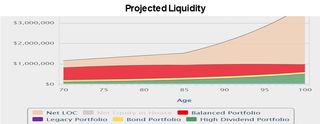How to Add Home Equity to Your Retirement Income Planning
Home equity is sometimes overlooked as a viable resource in retirement. You don’t have to sell your home to find income and liquidity.


With more retirees than ever choosing to age in place, the idea of selling your home to downsize may no longer be part of your plans.
That’s smart, because you don’t have to sell the homestead to produce retirement income and help cover the costs associated with a critical health crisis, or just the effects of aging that require outside care.
In the New York Times article The High-Class Problem That Comes With Home Equity, author Ron Lieber, the NYT’s Your Money columnist, suggests that reverse mortgages could be a good product for some retirees who want to tap the equity in their home without selling. We agree, and the Go2Income planning method can now incorporate a reverse mortgage.

Sign up for Kiplinger’s Free E-Newsletters
Profit and prosper with the best of expert advice on investing, taxes, retirement, personal finance and more - straight to your e-mail.
Profit and prosper with the best of expert advice - straight to your e-mail.
I have found that lifetime income, liquidity for unplanned expenses, lower taxes and a financial legacy are the objectives most retirees seek. When they also want to stay in their homes or age in place, I propose that annuities and home equity, added to traditional savings and investments, will best meet their retirement goals.
In our previous article, The (R)evolution of Retirement Income Planning, we presented the advantages of a plan based on investments, annuities and a home equity conversion mortgage, or HECM. Let’s dig deeper into that plan for our sample investor. You’ll see the key elements and how they can be customized to your personal objectives.
Sally’s case
Sally, 70, is focused on starting income. She has $1.5 million in savings (50% in a rollover IRA account) and $1 million in the value of her house (without any mortgage). She understands that with income annuities added to her plans, she can be a little more aggressive and wants starting income of $96,000 a year — translating to 6.4% of her retirement savings, or 60% higher than the 4% rule. (Together with her $62,000 in Social Security benefits and pension, she’s up to $158,000 in starting income.)
The following charts tell her story.
The first is her sources of income chart with Go2Income split into three sources:
- Investment portfolios: Dividends and interest from personal (after-tax) savings, RMDs and withdrawals from her rollover IRA account
- Annuities: Single-premium immediate annuity that provides lifetime annuity payments generated from personal (after-tax) savings for tax efficiency
- Home Equity2Income (H2I): HECM drawdowns until 85; QLAC lifetime annuity payments less HECM interest after 85

The product elements are allocated to accounts based in part on tax efficiency, and for Sally’s plan, less than 40% of the first-year income is taxable, with over $92,500 of the $96,000 becoming her spendable income. Also, a very large percentage of income is safe, meaning she doesn’t have to liquidate securities to realize the cash flow. Nearly 60% is safe over her lifetime.
The second chart is her projected liquidity, which may be the biggest surprise, with liquid funds to cover planned and unplanned expenses, like long-term care, modifying the house for aging-in-place necessities, etc. These funds are made up of the following:
- Investment portfolios: High-dividend portfolio (personal savings), fixed income portfolio (personal savings) and balanced portfolio (rollover IRA account)
- Home Equity2Income: HECM net line of credit

This plan meets Sally’s objectives for lifetime income, but also provides substantial liquidity for late-in-life spending — both planned and unplanned.
A reminder of the world before the evolution of retirement
It wasn’t so long ago when almost all retirees could be comfortable with income from Social Security benefits, savings and perhaps a pension or an IRA.
For most of us, pensions are now unattainable. Happily, Social Security is designed to be lifetime income, and if you worked 40 years and paid into the program, it will provide a good chunk of safe income. Your savings also might provide significant income, but investments in stocks and bonds can vary from year to year. In our prior article, we showed how each product element improved the results, in terms of income, liquidity, taxes and safety.
Another application of H2I
It doesn’t appear that we will ever go back to the days when we could retire without thinking too much about the income that we knew would flow in each month from a pension and Social Security. The (R)evolution of Retirement article, however, provides the information to help you make the decisions required by today’s environment.
When I was running the product area of a life insurance company, I knew that customers liked the lifetime protection of annuities. But some didn’t want to give up access to their funds. Back then, I got a patent on something called the Income Manager, which enabled the annuitant to cash in future payments and get access to some funds. While I can’t violate the patent, there is a need there that might be fulfilled somewhat differently:
By combining an HECM with annuities in different proportions, consumers get lifetime income (although at lower levels than Sally chose) and still maintain a large portion of savings as liquid. The available line of credit from HECM nearly matches the premium for the annuity and thus maintains most of your liquidity while gaining the annuity’s lifetime protection. We’ll explain in more detail in the next article.
Visit Go2Income Personal Planning to start a plan risk-free. You can ask one of our analysts to help you make adjustments. And then decide whether you want the peace of mind that lifetime income and greater liquidity can provide.
Related Content
Get Kiplinger Today newsletter — free
Profit and prosper with the best of Kiplinger's advice on investing, taxes, retirement, personal finance and much more. Delivered daily. Enter your email in the box and click Sign Me Up.

Jerry Golden is the founder and CEO of Golden Retirement Advisors Inc. He specializes in helping consumers create retirement plans that provide income that cannot be outlived. Find out more at Go2income.com, where consumers can explore all types of income annuity options, anonymously and at no cost.
-
 The 6 Best Places to Put Your Tax Refund for Growth
The 6 Best Places to Put Your Tax Refund for GrowthUse your 2024 tax refund to boost short-term or long-term financial goals by putting it in one of these six places.
By Rachael Green Published
-
 Five Great Places to Live in Wyoming
Five Great Places to Live in WyomingWhether you prefer the buzzy affluence of Jackson Hole, rodeo towns or mountain towns, Wyoming should be on any nature lover’s list.
By Drew Limsky Published
-
 How to Age-Proof Your Retirement Plan
How to Age-Proof Your Retirement PlanLongevity risk is a big threat to your retirement, but there are several strategies to protect yourself from running out of money, no matter how long you live.
By Nico Pesci Published
-
 Retirement Planning for Couples With a Generation Gap
Retirement Planning for Couples With a Generation GapDo you and your partner have different retirement timelines and attitudes to saving? It is possible to make plans together. This is how one couple did it.
By Phil Wright, Certified Fund Specialist Published
-
 Q1 Post-Mortem: The Market Shifts You Don't Want to Ignore
Q1 Post-Mortem: The Market Shifts You Don't Want to IgnoreAs the second quarter gets underway, here are some takeaways from the market's first-quarter performance to consider as you make your investment decisions.
By Prem Patel, MBA, IAR Published
-
 How to Replace a Corporate Trustee (and Make Other Trust Changes)
How to Replace a Corporate Trustee (and Make Other Trust Changes)The right choice of trustee today may not be the right choice for trust beneficiaries in the future. Here's what you should know.
By Christopher F. Tate, J.D. Published
-
 How to Balance Your Insurance Expectations vs the Reality
How to Balance Your Insurance Expectations vs the RealityJust because you have an insurance policy doesn't mean that you're totally covered in the event something bad happens.
By Karl Susman, CPCU, LUTCF, CIC, CSFP, CFS, CPIA, AAI-M, PLCS Published
-
 How Building Liquidity Into Your Retirement Plan Can Pay Off
How Building Liquidity Into Your Retirement Plan Can Pay OffTo succeed in investing for retirement, you need time and discipline — liquidity can give you both.
By Samantha Compton, IAR Published
-
 Striking Oil in Opportunity Zones: Now Might Be the Best Time to Invest
Striking Oil in Opportunity Zones: Now Might Be the Best Time to InvestYou could unlock hidden wealth in QOZs with strategic oil and gas investments, potentially combining tax advantages with long-term growth in an essential industry.
By Daniel Goodwin Published
-
 What You Don't Know About Annuities Can Hurt You
What You Don't Know About Annuities Can Hurt YouLack of awareness leads many to overlook these potent financial tools, and with the possibility of running out of money in retirement, that could really hurt.
By Ken Nuss Published